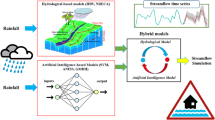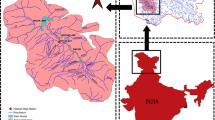Abstract
The streamflow prediction is an essentially important aspect of any watershed modelling. The black box models (soft computing techniques) have proven to be an efficient alternative to physical (traditional) methods for simulating streamflow and sediment yield of the catchments. The present study focusses on development of models using ANN and fuzzy logic (FL) algorithm for predicting the streamflow for catchment of Savitri River Basin. The input vector to these models were daily rainfall, mean daily evaporation, mean daily temperature and lag streamflow used. In the present study, 20 years (1992–2011) rainfall and other hydrological data were considered, of which 13 years (1992–2004) was for training and rest 7 years (2005–2011) for validation of the models. The mode performance was evaluated by R, RMSE, EV, CE, and MAD statistical parameters. It was found that, ANN model performance improved with increasing input vectors. The results with fuzzy logic models predict the streamflow with single input as rainfall better in comparison to multiple input vectors. While comparing both ANN and FL algorithms for prediction of streamflow, ANN model performance is quite superior.








Similar content being viewed by others
References
Abraham B and Ledoltor J 1983 Statistical methods for forecasting; John Wiley and Sons Inc., New York, 472p.
Chang L C, Chang F J and Sai Y H T 2005 Fuzzy exemplar-based inference system for flood forecasting; Water Resour. Res. 41. doi: 10.1029/2004WR003037.
Fernando D A K and Jayawardena A W 1998 Runoff forecasting using RBF networks with OLS algorithm; J. Hydrol. Eng. 3 203–209.
Jain S K and Srivastava D K 1999 Application of ANN for reservoir in flow prediction and operation; J. Water Resour. Plan. Manag. 125 263–271.
Gowda C C and Moyya S D 2014 Runoff modelling using different membership functions in adaptive neuro fuzzy inference system; Int. J. Adv. Eng. Sci. 4 (4) 48–51.
Hong Y S, Rosen M R and Reeves R R 2002 Dynamic fuzzy modelling of storm water infiltration in urban fractured aquifers; J. Hydrol. Eng. 7 (5) 380–391.
Hsu K, Gupta H V and Sorooshian S 1995 Artificial neural network modelling of the rainfall–runoff process; Water Resour. Res. 31 2517–2530.
Mamdani E H and Assilian S 1975 An experiment in linguistic synthesis with a fuzzy logic controller; Int. J. Man–Machine Studies 7 (1) 1–13.
Maskey S, Guinot V and Price R K 2004 Treatment of precipitation uncertainty in rainfall-runoff modelling: A fuzzy set approach; Adv. Water Resour. 27 (9) 889–898.
Mukerji A, Chatterjee C. and Raghuwanshi N. S. 2009 Flood forecasting using ANN, Neuro-Fuzzy, and Neuro-GA models; J. Hydrol. Eng. 14 (6) 647–652.
Nash J F and Sutcliffe J V 1970 River flow forecasting through conceptual models; J. Hydrol. Sci. 44 399–417.
Nayak P C, Sudheer K P and Ramasastri K S 2005 Fuzzy computing based rainfall–runoff model for real time flood forecasting; J. Hydrol. Process. 9 955–968.
Raghuwanshi N S, Singh R and Reddy L S 2006 Runoff and sediment yield modelling using artificial neural networks: Upper Siwane River, India; J. Hydrol. Eng. 11 71–79.
Rumelhart E, Hinton G and Williams R 1986 Learning internal representations by error propagation; Parallel Distributive Process 1 318–362.
Samani N, Gohari-Moghadam M and Safavi A A 2007 A simple neural network model for the determination of aquifer parameters; J. Hydrol. 340 1–11, doi: 0.1016/j.jhydrol.2007.03.017.
Senthil Kumar A R, Ojha C S P, Goyal M. K., Singh R D and Swamee P K 2012 Modelling of suspended sediment concentration at Kasol in India using ANN, fuzzy logic, and decision tree algorithms; J. Hydrol. Eng. ASAE 17 (3) 394–404.
Sen Z 1999 Fuzzy modelling in engineering; Class notes, Civil Engineering Faculty, Istanbul Technical Univ., Istanbul, Turkey (in Turkish).
Sinha Jitendra R K, Sahu Agrawal Avinash, Pali A K and Sinha B L 2013 Rainfall runoff modelling using multi-layer perceptron technique – A case study of the Upper Kharun Catchments in Chhattishgarh; J. Agr. Eng. 50 (2) 43–51.
Shivakumar B, Jayawardhane A W and Fernando T M K G 2002 River flow forecasting: Use of phase space reconstruction and artificial neural network approaches; J. Hydrol. 265 225–245.
Smith J and Sli R N 1995 Neural network model for rainfall runoff process; J. Water Res. Plan. Manag. ASCE 121 49–508.
Tayfur G and Singh V P 2006 ANN and fuzzy logic models for simulating event-based rainfall–runoff; J. Hydrol. Eng. 132 1321–1330.
Tayfur G, Moramorco T and Singh V P 2003 Predicting and forecasting flow discharge at sites receiving significant lateral inflow; Hydrol. Process. 21 1848–1859.
Tokar A S and Johnson P A 1999 Rainfall–runoff modelling using artificial neural networks; J. Hydrol. Eng. 4 232–239.
Tilmant A, Vanclooster M, Duckstein L and Persoons E 2002 Comparison of fuzzy and nonfuzzy optimal reservoir operating policies; J. Water Resour. Plan. Manag. 128 (6) 390–398.
Yeshewatesfa Hundecha, Andrass Bardossey and Hanse Warner Theisen 2001 Development of fuzzy logic based rainfall runoff model; J. Hydrol. Sci. 46 (3) 363–376.
Zadeh L A 1965 Fuzzy sets; Information and Control 8 (3) 338–353.
Acknowledgements
Authors are thankful to the Executive Engineer, Hydrologic Project Division, Nashik for providing streamflow and metrological data free of cost and to the Dean, College of Technology and Engineering, MPUAT, Udaipur for providing necessary facilities.
Author information
Authors and Affiliations
Corresponding author
Rights and permissions
About this article
Cite this article
Kothari, M., Gharde, K.D. Application of ANN and fuzzy logic algorithms for streamflow modelling of Savitri catchment. J Earth Syst Sci 124, 933–943 (2015). https://doi.org/10.1007/s12040-015-0592-7
Received:
Revised:
Accepted:
Published:
Issue Date:
DOI: https://doi.org/10.1007/s12040-015-0592-7




